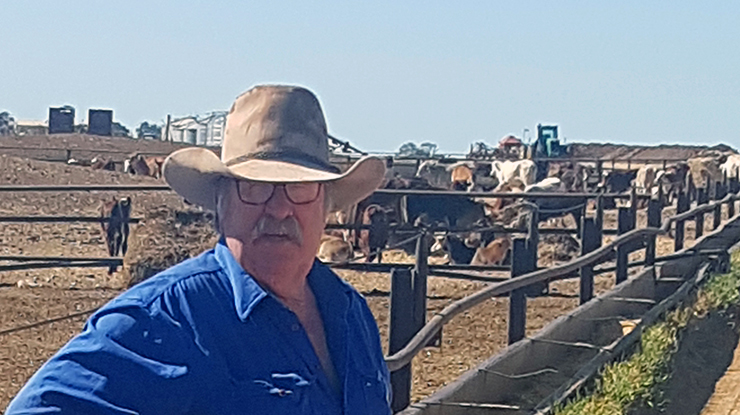Diversifying into MSA pays off for Kuruman Pastoral Company
01 October 2019
 Peter Saint, Kuruman Pastoral, Balaklava.
Peter Saint, Kuruman Pastoral, Balaklava.
Developing a production system where cattle are bred in the Northern Territory and finished in South Australia to target markets including Meat Standards Australia (MSA), is reaping rewards for the Saint family of Kuruman Pastoral Company.
Peter and Brenda Saint moved to Balaklava in the Mid North region of South Australia five years ago after 40 years at Kurundi Station, south east of Tennant Creek in the Northern Territory, to diversify their cattle business and value-add to a portion of their herd.
The Saints have been targeting MSA since they first moved to South Australia, and their results have seen them win the 2019 MSA Excellence in Eating Quality Progress Award for South Australia.
Peter and Brenda’s son, Ben with his wife Bec, continue to manage Kurundi Station where two separate breeding herds have been run, comprising Hereford and Brahman breeders.
Over the past five years as the breeders have aged, Ben has culled more of the Hereford and Brahman breeders and replaced them with more Droughtmaster type breeders.
Progeny are sent to Peter and Brenda for backgrounding and lot feeding across 2,500ha they own and lease in SA.
“We moved here initially because we were having problems selling the bottom 10% of our heifers and steers, and we value-added that 10% by bringing them to South Australia,” Peter said.
“Our Hereford herd, which we put Hereford and Droughtmaster bulls over, were traditionally sent to South Australia or Victoria.
“We put Brahman and Droughtmaster bulls over Braham females, and the steer portion used to go to live export while we kept the top heifers for breeding.
“However, when Indonesia increased the weight requirements of steers for the feeder market, it caused issues for us. Because breeder numbers had been built up, it meant we had to wean cattle and keep them for longer before they could go on to the boats.
“So today, probably 90% of turn off from Kurundi Station comes here now and I do all the marketing from here.
“Between 3,500 to 4,000 head a year come down here, and they’re predominantly our Hereford-Droughtmaster cross cattle. They’re processed at Teys Australia Naracoorte or Greenham’s at Moe, Victoria.”
Peter attributes their MSA results to their feeding program to ensure well-fed, content cattle, and also undertaking good animal husbandry practices.
“Traditionally, we grow our own grain and hay, although over the last 12 months have been buying grain due to the ongoing drying conditions,” Peter said.
“Before the cattle go into the feedlot, we do two things. We put grain out in troughs to get them used to having grain, while they’re still being backgrounded out in the paddocks.
“The paddocks are sown with improved pasture, so they’re on oats and vetch.
“We put the cattle from the station out onto the best feed we’ve got and they’re achieving weight gains out in the paddock before they go into the feedlot of between 700g to 1.2kg a day.
“I make a call on our grain paddocks and if I believe, like this year, that we’re probably not going to yield much grain because of the dry conditions, then I don’t hesitate to put cattle on them.
“Secondly, once they go into the feedlot, we induct them for about a week on a higher concentrate of hay then a full ration mix. We put a lot of hay into the feedlot pens so if they don’t feel like grain, they have the option to have hay.
“We also don’t mix mobs together – we keep lines of cattle together, and I don’t truck anything unless I believe it is a finished article, regardless of how long it has been on feed.
“We aim to turn them off at a minimum weight of about 450kg liveweight. Our liveweight to carcase weight conversion is around 55-56% on our steers and about 54-55% for our heifers.”
Peter said choosing Droughtmaster sires with the right traits to suit their landscape was also important.
“Because the cattle are on pastoral country, we only buy bulls with extremely sound feet because they have to walk a long way for feed,” Peter said.
“We’re tough on bull selection and we only buy bulls with milk teeth, weighing about 750kg, with good rumps and plenty of muscling.”


